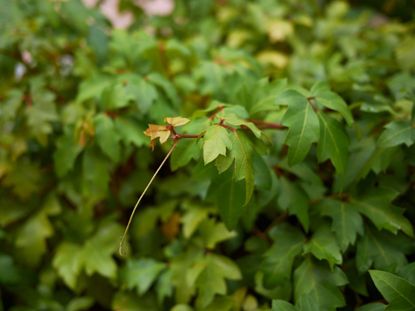Grape Ivy Is Turning Yellow: What To Do For A Grape Ivy With Yellow Leaves


Grape ivy is one of the finest indoor vines a gardener can grow. It’s hardy, looks nice, and springs back despite a great deal of neglect. Because of this, many people are surprised to hear about grape ivy plant problems, but they do suffer a few. Yellow leaves on grape ivy are by far the most common and can be caused by a couple of different mechanisms. Read on to learn more about grape ivy with yellow leaves.
0Causes of Yellow Grape Ivy
When your grape ivy is turning yellow, you may be really concerned that it won’t survive the ordeal – and you may be right. Although there’s not much that can get these hardy plants down, yellow leaves can be a sign of serious distress. It’s time to do a little detective work to find out what’s causing your plant’s problem. By far, the two most common causes of yellow leaves on grape ivy are spider mites and root rot. Both are treatable if caught early. Here’s what to watch for and what to do if you find it: Spider Mites. Spider mites leave a characteristic thin spider-like web on your plants, along with pin-sized yellow spots on leaves that aren’t fully affected yet. If you suspect spider mites, washing the plant thoroughly once a week and increasing the humidity around it can help keep them at bay. If they’re persistent, a miticide is in order. Apply it carefully, and per the package instructions. Root Rot. Root rot is the direct result of overwatering. In a plant like grape ivy, which prefers a dry soil, root rot can be a serious problem long before you realize. It can manifest in several ways, but yellow or wilting leaves are typical signs that your plant’s roots aren’t doing their job. Remove the plant from its pot and clean the dirt out of the root ball gently. If many of the roots are brown, black, smell terrible, or appear dead, you’ve got a problem. Trim back all the sickly roots and repot your plant into a container that drains quickly. Make sure to use a fast-draining potting soil, such as a palm or cactus mix. Water the plant when the soil feels dry and never leave it standing in a saucer full of water.
Gardening tips, videos, info and more delivered right to your inbox!
Sign up for the Gardening Know How newsletter today and receive a free download of our most popular eBook "How to Grow Delicious Tomatoes."

Kristi Waterworth was a regular contributor to Gardening Know How for many years, answering countless queries on plant pests and diseases.
-
 Want a Backyard Mini Orchard? Create Your Own Container Orchard
Want a Backyard Mini Orchard? Create Your Own Container OrchardEasier to care for in small spaces, a backyard mini-orchard makes sense for busy gardeners and juicy fruit is the reward.
By Teo Spengler
-
 Urban Beekeeping Guide: Top Tips For Raising Bees In The City
Urban Beekeeping Guide: Top Tips For Raising Bees In The CityUrban beekeeping can be a rewarding and appreciated pastime, but first be sure it’s legal in your city and learn the ropes of beekeeping.
By Mary Ellen Ellis
-
Possum Grape Vine Info – Tips For Growing Arizona Grape Ivy
Gardeners who have an ugly wall or underused vertical space, may want to try growing Arizona grape ivy. What is Arizona grape ivy? Find out more about this attractive, ornamental vine in the article that follows.
By Bonnie L. Grant
-
 Grape Ivy Plants - How To Care For A Grape Ivy Houseplant
Grape Ivy Plants - How To Care For A Grape Ivy HouseplantGrape ivy is a member of the grape family and in form resembles other ornamental vines which share the name ivy. Read this article for tips on growing grape ivy as houseplants.
By Amy Grant